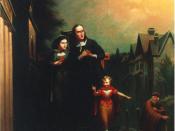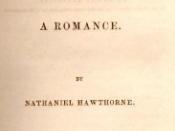She's Worth More Than a Diamond
Pearls have always held a great price to mankind, but no pearl had ever been earned at as high a cost to a person as Hester Prynne, a powerful heroine in Nathaniel Hawthorne's novel The Scarlet Letter. Pearl, born into a Puritan prison in more ways than one, is a mysterious character serving entirely as a vehicle for symbolism.
From her introduction as an infant on her mother's scaffold of shame to the peak of the story, Pearl is a caring and intelligent child. Throughout the story she finds the hidden emotions of her mother and magnifies them for all to see. Pearl is the heart of literary symbolism. She is at times a device for Hawthorne to express the inconsistent and blurry qualities of Hester and Dimmesdale's illegal bond at times, and at others a forceful reminder of her mother's sin.
Pearl is her mother's most precious possession and her only reason to live, but she also serves as a priceless treasure purchased with her life. The product of Hester's sin and suffering, Pearl, was a painfully constant reminder of her mother's sin. Hester herself felt that Pearl was given to her not only as a blessing but a punishment worse than death or public humiliation. She is tormented by her daughter's childish and constant teasing and endless questioning about the scarlet letter and it's relation to Minister Dimmesdale. After Pearl has created a letter "A" on her own breast out of seaweed, she asks her mother, "But in good earnest, now, mother dear, what does this scarlet letter mean? -And why dost thou wear it on thy bosom"(Hawthorne 123), "and why does the minister keep his hand over his heart"(Hawthorne 123) In saying this Pearl implies that she knows plenty...


